Maine winter’s freezing temperatures and constant snowfall is a bit of a mixed blessing. One one hand, shooting from a bench outdoors is not as much fun as one might assume. On the other hand, being cooped up in a nice warm shop gave me an opportunity to listen to an old Live From Sessions at West 54th performance, John Prine and Iris DeMent. “In Spite of Ourselves” which made the chore of brass cleaning almost fun. A fortuitous circumstance as it was time to finish “Ruger’s Hawkeye Predator in 223 Rem Part II”.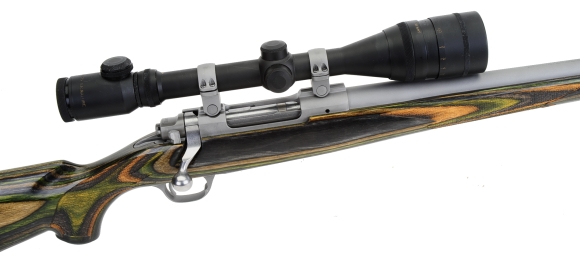 For my personal purposes when reloading, brass gets decapped, tossed into a vibratory cleaner with ground walnut, gets full length resized, checked to spec, and then gets assembled into cartridges. The brass looks good outside and won’t contaminate reloading tools and equipment, primer pockets are cleaned up to remove any ignition remnants. I don’t sort brass by manufacturer and, if they are dimensionally in spec and pass a visual inspection, I clean up the case mouth with a reamer but I don’t trim. In a good rifle, if the rest of the assembly is done consistently, this level of handload will shoot sub MOA all day long.
For my personal purposes when reloading, brass gets decapped, tossed into a vibratory cleaner with ground walnut, gets full length resized, checked to spec, and then gets assembled into cartridges. The brass looks good outside and won’t contaminate reloading tools and equipment, primer pockets are cleaned up to remove any ignition remnants. I don’t sort brass by manufacturer and, if they are dimensionally in spec and pass a visual inspection, I clean up the case mouth with a reamer but I don’t trim. In a good rifle, if the rest of the assembly is done consistently, this level of handload will shoot sub MOA all day long.
The following is some detail of brass prep and handling for firearm and component review process. If you would prefer, you can skip past these sections and get to the handload data that was used and a summary of the Ruger Hawkeye Predator’s performance.
Why is brass prep such a dirty process?
Review products can’t be treated the same way. Reviews are a public statement about a manufacturer’s firearm and its performance, so there is an obligated to make sure a casual approach to handloads doesn’t diminish a good product. Subsequently, case prep and cartridge assembly have to go a more tedious route.
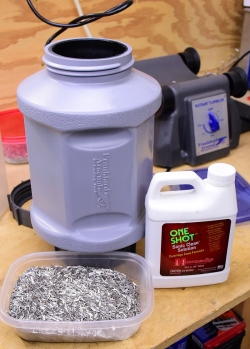 Brass around here does not enter the cleaning process in pristine condition. It is felt tip pen marked and often shot from suppressed, semi-auto firearms that leave it soot blackened.
Brass around here does not enter the cleaning process in pristine condition. It is felt tip pen marked and often shot from suppressed, semi-auto firearms that leave it soot blackened.
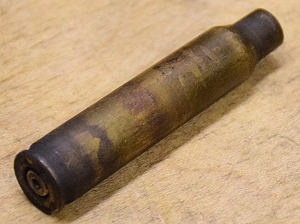
After trying a good number of approaches to cleaning brass… chemical, vibratory cleaner with dry media, dry and wet drum, I’ve settled on a wet drum, cleaning chemicals and stainless steel pins. More specifically, cases are decapped, dumped in the drum with Hornady One Shot Sonic Cleaner and well water, then the drum is set to spin for an hour. Yes, I do know it is sonic cleaning chemical and, yes, I do know this is not a sonic cleaner. Yes, I do know that distilled water is supposed to eliminate spots, but One Shot is also a wetting agent and the cases come out bright and I don’t mind a few spots from tap water.
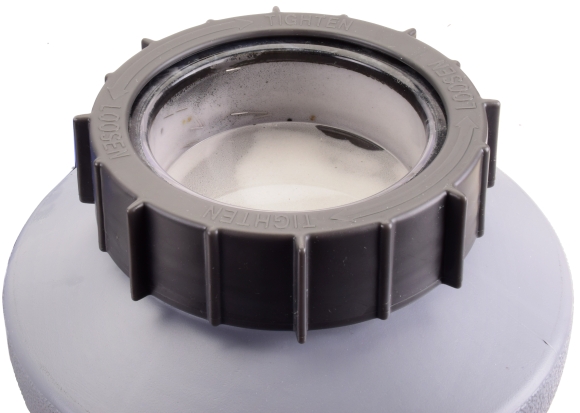
Poly drum tumblers with end caps leak and it doesn’t matter the quality or brand. My theory is that the cap is fairly rigid and with planar surfaces, where the poly drum gasket surfaces are not. Unfortunately, the torque used to tighten the cap is not sufficient to draw the drum’s gasket surface into compliance with the cap, so end caps tend to dribble. The super technical fix is to fill the drum with brass, cleaning solution and water, install and tighten the end caps, hold the drum by the end caps and drop it on the bench for a height of a few inches, then re-tighten the caps. Like a water balloon, the drum will expand into the barrel threads into the caps and re-tightening the caps will assure a water tight seal. Hey, it beats having liquid run out and down to the electric motorized base.
The Frankford Arsenal unit pictures is actually a pretty rugged unit and it spins at a fairly rapid rate. I did not put a tachometer on it, but I’d say close to standing on a treadmill and hitting the 10 MPH button. It has a rubber liner, but that does more to protect the inside of the drum from wear and tear than to reduce the racket it makes. Would not expect more from a spinning drum full of empty brass and stainless steel pins. A half hour is generally enough, but I run it for an hour so there is no manual cleaning and case interiors and primer pockets are spotless.
No more wandering steel pins
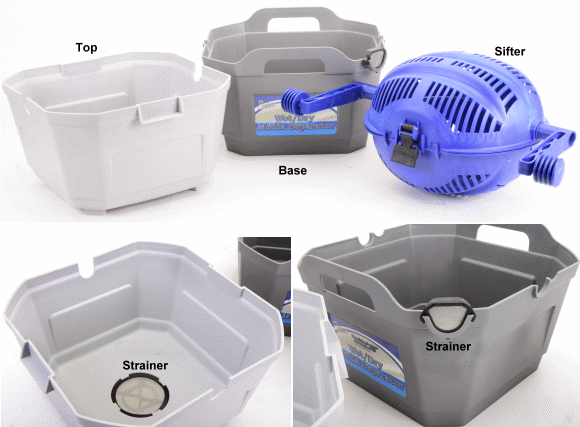
I picked… that means I purchased and paid for, the Frankford Arsenal Wet/Dry Media Separator because it works the best of those I have tried. The benefit lies in removing steel pins and liquid cleaner from the nicely cleaned brass, without having to chase steel pins away from sink drains, work benches and every crack and crevice in the shop.
The sifter is opened and parked on the base. The drum is dumped… brass, pins and cleaner into the bottom of the sifter and then the sifter is closed and latched. The base is half filled with water, the top is flipped over and placed on top of the base, and then the sifter handles are turned. Turning the sifter half submerged in water flushes out the pins and chemical residue from the brass and into the base. The sifter is lifted from the base and the base is then tipped so that the liquid runs out through its strainer, while retaining the steel pins for recovery. The sifter can then be placed in the inverted top and flushed under a faucet while draining through the strainer in the bottom.
An alternate theory of opertion
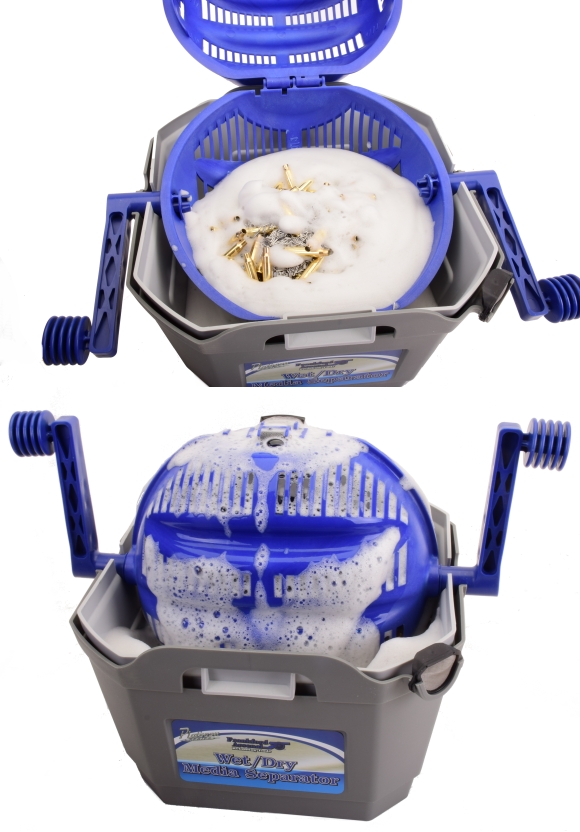
The top is inverted and dropped into the base and the open sifter is placed. The drum contents of brass, cleaner and steel pins are dumped into the open sifter, then the softer is closed and latched. The tub is half filled with water and spinning the sifter will eject the steel pins and dirty water into the inverted top. The liquid will pass through the top’s strainer, which is now on the bottom, and into the base until it overflows the base strainer. The steel pins are retained in the inverted top where they are easy to flush and dump into a container. The top can then be lifted out and placed in a sink under running water so the brass can be flushed.
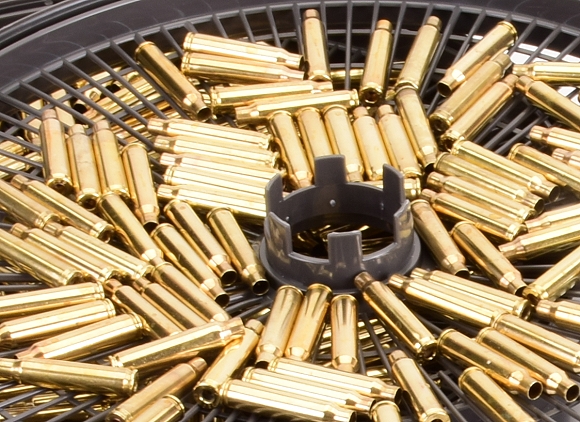
As above, all of the brass came out bright and clean, inside and out, without rounded rims and other edges as is the case with prolonged dry media vibratory cleaning. The Frankford Arsenal case dryer is what all other case dryers are, a food dehydrator, branded and repurposed for another application. Whenever cases are submerged in water or rinsed, no matter how they are shaken out, or left on a counter to dry, they will hold primer killing droplets of water for approximately 27 years. OK, more like a few days, unless they are heat dried. The brass dryer will do the same in any hour. I wish they would put an off switch and timer on this unit as their absence is a bit disconcerting.
Yes, I did try steel pins in a vibratory cleaner. The brass basically floated on the surface. I mixed the pins with corn media; the pins clumped, the vibration was dampened and the result was something less than corn media alone. I tried pins and not liquid in the tumbler and pins and corn media with poor results. When used as instructed by the stainless steel pin media manufacturer, the detergent solution softens powder and primer residue and carries the pins into contact with the brass in an aggressive fashion.
Is there more to do? Sort of…
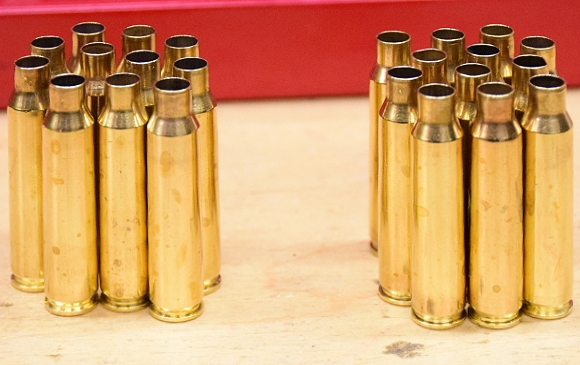
Once fired brass is sorted by manufacturer and then inspected for body and/or neck cracks or internal stress rings above the case web. Brass that passes visual inspect are full length sized and cut to trim to length which, in this case, is 1.750″. Case mouths are reamed inside and out. Sorting is done to minimize case to case capacity run out, trimming is done after sizing because sizing tends to stretch brass length.
H2O, water, is the standard used to measure case capacity because of its constant density and ability to flow to all interior case areas. Smokeless powder is not used to define capacity because of its variety of shapes and sizes and densities. That’s why it is easy to to load 109% of wet capacity with Benchmark, but only 20% with Trail Boss even though the case has a finite and constant physical volume.
Checking cases after sorting by brand and lot yielded the following case weight/H2O capacity expressed in grains: Federal=93.9/30.4, Hornady=97.8/30.4, PPU=97.3/30.6, Remington=94.7/30.9. So a half grain swing in capacity, which directly impacts pressure and velocity. Mixing brass with this type of difference in capacity is like seating bullets to all different depths. It may not show in casual shooting, but it shows up as shifts in point of impact under precise, controlled condition.
Sizing before trimming assures uniform length of the case before assembly. When the ram on a reloading press is raised and the case is pressed into the full length sizer die, the decapping rod with expander ball passes through and clears the case neck, before the neck is sized down. When the press handle is raised, the case neck clears the forming portion of the sizer die and the expander ball is pulled back through the case neck. During this process, in regard to this project, the neck is reduced to a 0.220″ inside diameter. Then the 0.223″ expander ball is pulled back through the neck; it tugs at the case shoulder and, with some brass spring back, reopens the neck to 0.222″. The 0.004″ provides the neck tension to retain a bullet. In this example, Remington – Peters brass was selected. In a raw, clean state it measured 1.756″ in length. After sizing, between body compression and neck sizing, the cases grew to 1.763″, or 0.003″ longer than maximum case length specification. It was all trimmed back to 1.750″.
Charges were measured with a digital scale with 0.1 grain +/- accuracy. Bullet seating was done with a recessed seater plug that made contact on the slope of the bullet’s ogive rather than the tip and an overall cartridge length gauge that referenced the slope of the ogive and not the bullet tip was used to set and measure cartridge overall length. All of this is a wayyyy round about way to suggest the more uniform the cartridge assembly, the more uniform pressure and bullet velocity. Bullets have the same barrel time, velocity is near the same and chances are bullets will closely replicate point of impact.
What happens when the results look like a scatter gun? In Dalton’s words, “Opinions vary”. Personally, I shoot a couple of types of factory ammo to see if the rifle shoots the same or if it improves. If it shoots the same, I start looking at the rifle and check for weird pressure points or improperly tightened action to stock fasteners. If the rifle does well with factory ammo, I stop looking at the rifle and adjust my handloads: vary powder charges within limits, vary powder types, vary bullet types, varying seating depth to find a load that compliments the hardware. After such sorting, the following emerged.
Old or new?
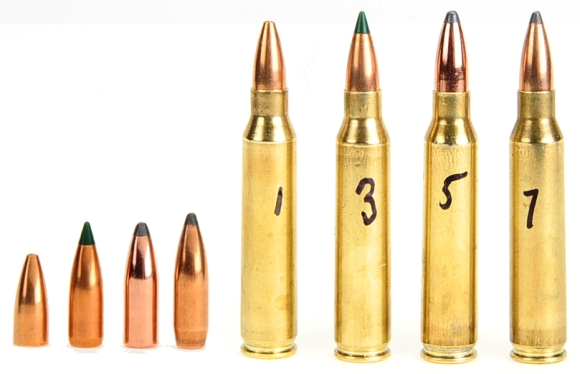
For some, handloading is a future game; continually bring in whatever is new and work it until its potential is extracted. For other, handloading is experience; develop loads that meet all objective and don’t fix what isn’t broken. I’m afraid I am the latter. When I have a combination that works, high performance within an application, I typically stick with what I have. Excursions into “new” happens when my curiosity gets the best of me or I use the last of the 10,000 piece lot of favorite brand and type of bullet I bought in 1965. The bullet selection here isn’t quite that bad, but they are not composite, or stepped, or Astatine jacketed alloy. They are also not shaped like little rocket ships to draw the attention of gamers.
| Cartridge – 223 Remington |
|
| Firearm | Ruger Hawkeye Predator |
| Barrel Length | 22.00″ |
| Min – Max Case Length | 1.760″ +0.000″/-0.030″ |
| Min – Max COL | 2.125″ – 2.260″ |
| Primer | CCI BR4 |
| Bullet Diameter | 0.2245″ +0.000″/-0.0030″ |
| Reloading Dies | RCBS |
| Bullet Type | Bullet Weight Grains |
Net H2O Grains Capacity |
COL” | Powder Type | Powder Charge Grains |
Muzzle Velocity fps |
Muzzle Energy ft/lbs |
100 Yard 3 Shot Group ” |
| Sierra Varminter JHP | 40 |
27.3 |
2.175 |
Re7 | 24.5 | 3692 | 1211 | 0.6 |
| Sierra Varminter JHP | 40 | 27.3 | 2.175 | H335 | 29.0 | 3669 | 1196 | 0.5 |
| Sierra BlitzKing | 50 |
25.9 |
2.250 |
CFE 223 | 28.5 | 3304 | 1212 | 0.4 |
| Sierra BlitzKing | 50 | 25.9 | 2.250 | AR-Comp | 25.5 | 3376 | 1266 | 0.4 |
| Nosler Partition | 60 | 25.9 | 2.260 | CFE 223 | 28.0 | 3190 | 1356 | 0.5 |
| Nosler Partition | 60 | 25.9 | 2.260 | AR-Comp | 24.0 | 3130 | 1306 | 0.7 |
| Sierra GameKing | 65 | 25.9 | 2.250 | CFE 223 | 27.0 | 2994 | 1294 | 0.2 |
| Sierra GameKing | 65 | 25.9 | 2.250 | AR-Comp | 23.5 | 2991 | 1292 | 0.5 |
So what is so special about the Ruger Hawkeye Predator?
The Predator feels like a varmint or target rifle, it’s built like a tank, but at 7.7 lbs it weighs not much more than a sporter. It can out shoot most riflemen and most handloads. OK Joe, what the heck does that mean? Just that the rifle has a lot more potential than will most of its owners. Shooting and handloading, I kept thinking I should keep on working because there would always be more potential to extract. Subjectively, the Hawkeye Predator is a good looking rifle, backed by a rock solid Ruger organization and sold at a value price for a rifle that will last a few life times.
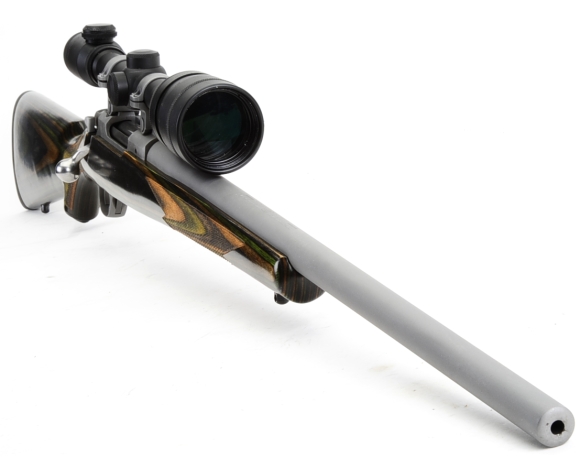

Email Notification